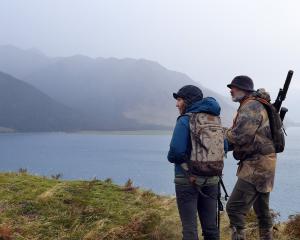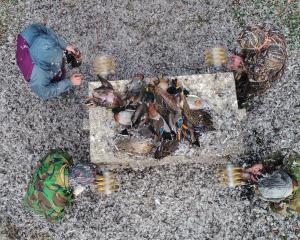Two recent incidents in which hunters have been shot and killed by other hunters have again raised the question of how to make hunting safer. As Mark Price reports, growing numbers of hunters are quietly adopting a contentious safety measure that can be described as very "loud".
Tight-fitting pencil skirts, cropped jackets and cardigans, cobalt, red and yellow skinny jeans, 1960s style shift dresses, leopard prints, chunky knitwear ... these are, I am assured by an ODT staff fashionista, the fashion trends of the moment.
But, she neglects to mention the trend developing in the bush.
Red and black tartan, teamed with rugby shorts and white freezing works gumboots, is so last century.
Today bush fashion is embracing what some call "day-glo orange", some call "high-viz", some call "hunter orange" and some call "blaze orange".
In the vastness of the modern hunting apparel market, this hard-to-ignore colour (13 parts yellow, three parts warm red, quarter-part black) stands out as an increasingly popular fashion choice.
And the reason is as obvious as the clothes.
Hunters want other hunters to know they are not a deer, or a pig, or a moose, and that they are therefore not a target.
Most hunting fatalities in New Zealand - those involving a firearm - are the result of one basic hunting rule being broken.
Those at fault have not identified their target.
Fixing that problem has exercised the great minds of the hunting world internationally, and wearing high-visibility clothing is one solution they have come up with.
The Americans led the way and now such clothing is mandatory in more than 40 of that country's 50 states.
Here hunters still have the choice although, says the owner of Upper Hutt clothing manufacturer Huntech, Stephen Richards, the choice is often made by a hunter's family.
"I think the pressure does come from families. They are the ones most affected. Hunters are a bit blase about things."
He produces a small range of what he calls "high-viz" clothing. But he is not claiming such clothing is the silver bullet, citing incidents in the United States when hunters wearing it have been shot.
"I'm not 100% convinced myself."
Richards says one of the problems is that the high-viz orange fades "very quickly".
"All you need to do is look at road cones.
"They go pink very quickly; they lose all their oomph and that's just the nature of the dyes and the fabrics."
Allan Millar's Hunting & Fishing manager Scott Kunac calls it "blaze orange" rather than "high-viz" but concurs on the fade issue.
While, he says, new blaze orange "just glows in the dark" older garments that have been washed and have been out in the sun lose their brightness, changing to a colour not dissimilar to a red deer in summer when it has "a very bright orange, gingery coat".
An experienced Otago hunter, who did not want to be named, agreed, saying high-visibility orange clothing became more red deer-like as it got dirty.
He preferred to wear royal blue in a camouflage pattern because it was not a colour associated with any animal.
And he did not believe royal blue was more likely than orange to alert deer.
"There is a huge number of dead deer, including some of the biggest stags shot in Otago, that have been taken wearing that [colour]."
Tauranga clothing manufacturer Stoney Creek, which first introduced "blaze orange" to New Zealand in 1996, claims "cheap imitations" are more prone to fading.
Marketing manager Amanda Crosby: "All fabric fades with time and wear. What we are saying, is that there are cheap fabrics that will fade much quicker with little time and use and therefore reduce their effectiveness."
She says the company continued to see the sales of blaze items grow - "particularly in outer pieces, such as headwear, vests and packs" - and suggests hunting fathers choose blaze for their sons.
"We are constantly getting positive feedback from hunters regarding the peace of mind this provides."
Another Stoney Creek spokeswoman, Nichola Maclean, says store owners "literally laughed" when first introduced to the "bizarre concept" of blaze orange but now it was an "essential" part of hunters' kits.
She says that to a deer, greens, browns, yellows, reds and blaze orange all appear as a yellowish green (others suggest grey with a faint tinge of sepia) and therefore a hunter wearing blaze orange would remain unnoticed by deer.
The New Zealand Deerstalkers Association is right behind the use of hunter orange.
Co-ordinator of the association's national training scheme Bill O'Leary says its use was "increasing dramatically" and it had been included in the association's hunting guidelines.
"We really, really encourage our hunters to wear it."
There are hunting exceptions however.
Ducks have the ability to spot bright colours and therefore the clothing is not recommended for duck-shooting.
But when it comes to hunting deer, pigs, quail and pheasants, O'Leary likens it to wearing a seat belt in a car or the rule prohibiting the use of a hand-held cellphone while driving.
"The point about hunter orange is ... it's an aid to survival. It doesn't guarantee it."
Unlike seatbelts and the prohibition on using hand-held cellphones while driving, wearing high visibility clothing while hunting is not mandatory.
O'Leary does not expect that to change but believes it could become a requirement in certain hunting areas.
"It happens to some extent now. If you go and hunt in a private forest one of the conditions of having a permit is that when you are in the forest you are wearing high-viz gear.
"And people do it. They just do it automatically."
High-visibility clothing is particularly popular in autumn when large numbers of hunters are attracted to the bush by the mating roar of the male deer.
Retailer Scott Kunac says it is popular then because hunters realise there will be a lot more people in the bush than usual.
"It's a much busier place and a hunter that generally may not wear blaze normally would during the roar."
In 2003, police inspector Joe Green produced a paper analysing hunter safety issues in New Zealand.
He noted a report in the state of Virginia that of 983 hunters shot in a 41-year period, 242 (24%) were wearing orange clothing.
Nevertheless, he placed wearing clothing "that contrasts with the environment" second on a list of the 20 most effective ways hunters could prevent fatalities - the most effective way being for hunters to positively identify their targets.
Asked by the ODT if he considered high-visibility clothing should be mandatory, Inspector Green said there were cases "where high-viz clothing has been the target".
"So, in those cases it is not protective. [And] there are cases where it has not been seen, so is irrelevant.
"The answer is that it might be protective, and it might not.
"The best approach in my view is that taken by NZDA; a wise hunter will wear clothing that contrasts with the environment."
Caution over labelling high-visibility clothing as the safety silver bullet is perfectly illustrated by a single photograph that came to light following the last shooting fatality in a Wairarapa forest at Easter.
The photo shows 29-year-old Cam McDonald three hours before he was fatally shot in the head.
In the photo this hunter, who had a reputation for being safety-conscious, is wearing a bright orange hat.
The police and coroner have yet to determine the circumstances in that fatal shooting but Otago NZDA president Franz Laas recalled a previous case of a hunter wearing a "day-glo" hat being shot in the head.
"If you go in the bush you will actually understand why high-viz is not necessarily [the answer].
"There are some issues with colour that changes within the forest environment.
"It's quite complicated but when you have actually seen it in real life, you can see high-viz is not an absolute thing."
Laas says the Otago branch encourages hunters to wear high-visibility clothing and he accepts it has "some benefits" but he pointed out even seatbelts could be lethal.
"But on average, the advantages outweigh the disadvantages."
Each of those spoken to by the ODT considered high-visibility clothing a good safety option for hunters.
But no-one considered it a better option than abiding by Rule 4 of the police arms code: "Identify your target beyond all doubt".
Rules of engagement
Rule 4 of the police arms code states hunters must "identify their target beyond all doubt" but it does not go into detail about how they should, or should not, do that.
New Zealand Deerstalkers Association national training scheme co-ordinator Bill O'Leary is unequivocal.
"We do not want, and I emphasise again, we do not want people using their [rifle's telescopic sight] to identify targets."
Mr O'Leary says in close-range bush shooting there is a tendency for hunters to want to get their rifle up to their shoulder in a hurry.
"When people are using telescopic sights, you have got tunnel vision.
"You are not using both eyes and therefore you don't have depth of perception and while the scope tends to bring the target in closer to you, the field of view is so restricted that you don't see the whole of the picture.
"We've had specific incidents where what has been identified by the person behind the rifle was the ear or the eye of a deer.
"They never saw the whole animal and what they actually shot was the ear or the eye of the victim."
He advises hunters to identify their target using binoculars rather than their scope.
"If you see anything in the bush assume that it's a human being until it's proven otherwise."
Rule 4 states: "You must positively identify your target beyond all doubt before firing.
"If in doubt, don't shoot.
"The shooter, and anyone supervising an unlicensed shooter, must both positively identify the target.
"Make absolutely certain that the movement, colour, sound and shape of your target is identified correctly.
"Identify all of the animal. Do not fire at movement only. Do not fire at colour only. Do not fire at sound only. Do not fire at shape only."












